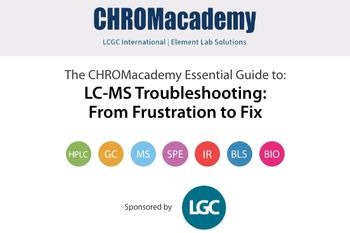
- LCGC Europe-05-01-2017
- Volume 30
- Issue 5
The Role of LC–MS in Lipidomics
Lipidomics, the analysis of lipids by mass spectrometric methods, revolutionized lipid science (1). It provides detailed quantitative information on hundreds of lipid species and opens new possibilities to gain an insight into lipid biology. This helps not only to explain the vital role of lipid species as membrane building blocks, but also to unravel their bioactive functions. Thus, lipid species can act as signaling molecules and modulate membrane properties, which are essential for organelle and membrane protein function. Moreover, the first examples demonstrated their potential as novel biomarkers to monitor human health.
Lipidomics, the analysis of lipids by mass spectrometric methods, revolutionized lipid science (1). It provides detailed quantitative information on hundreds of lipid species and opens new possibilities to gain an insight into lipid biology. This helps not only to explain the vital role of lipid species as membrane building blocks, but also to unravel their bioactive functions. Thus, lipid species can act as signaling molecules and modulate membrane properties, which are essential for organelle and membrane protein function. Moreover, the first examples demonstrated their potential as novel biomarkers to monitor human health (2).
Lipidomics research is based on two main approaches: direct infusion mass spectrometry (DIMS) analysis (shotgun lipidomics) and liquid chromatography (LC)–MS analysis. In direct infusion analysis a crude lipid extract is infused into the mass spectrometer and lipid species identification relies on specific precursor ion, neutral loss scans (3). The main advantage of infusion-based analysis is its simplicity and the straightforward way of quantification. Analytes and internal standards are present in the same sample matrix and thus experience the same ion suppression and matrix effects. Shotgun analysis is therefore able to provide comprehensive, quantitative lipidomes, as for example demonstrated for yeast (4). The application of high mass resolution, MSn, and derivatization–gas phase reactions can provide detailed lipid structures. However, the application of shotgun approaches is limited in sensitivity and separation of isomeric lipid species. Moreover, in-depth characterization of lipid species in crude lipid extracts may be complicated by co-isolation of precursor ions.
LC–MS provides separation of lipids and reduces the complexity of the matrix. It typically provides a higher sensitivity than shotgun and offers retention time as an additional parameter to identify lipid species. Therefore, low abundant lipid mediator species are typically analyzed by targeted LC–tandem mass spectrometry (MS/MS) (5). Lipidomic methods apply both reversed phase with nonpolar as well as normal phase and hydrophilic interaction chromatography (HILIC) with polar selectivity.
Reversed phase separates lipids species based on their hydrophobic moiety, that is, the hydrocarbon chain for most lipid classes. This allows the separation of hundreds of lipid species based on their chain lengths and double bond number (6,7). The retention behaviour follows certain rules and increases the confidence of lipid species identification. This permits the separation of isomeric lipid species with different acyl chains like PC 18:1_18:1 (phosphatidylcholine with two acyl chains containing 18 carbon atoms and 1 double bond) and PC 18:0_18:2 (18:0 and 18:2 acyl chain). However, quantification in lipidomics typically relies on lipid species not present in the samples. In reversed-phase chromatography most of the lipid species and internal standards elute at different times, thus experience different matrix effects and different solvent composition, which influences their ionization and may result in inaccurate quantification (8).
The polar selectivity of normal phase and HILIC provides lipid class-specific separation. This has great advantages in terms of quantification because analytes and internal standards show similar retention times. Moreover, identification of lipid species comprising a lipid class is straightforward. In contrast to reversed-phase methods, separation of acyl chain isomers is not usually possible by normal phase and HILIC methods, but lipid class-specific separation may resolve isomers like bis(monoacylglycero)phosphate and phosphatidylglycerol (9). A promising approach is the application of polar stationary phases with ultrahighâperformance supercritical fluid chromatography (UHPSFC), which offers ultrafast separation for quantitative analysis of multiple lipid classes (10).
Today, an increasing number of studies are reporting poor quality lipidomics data with misidentification and inaccurate or inappropriate quantification of lipid molecules. These studies primarily use untargeted metabolomics approaches (11) and the reasons for the poor data quality include analytical, bioinformatics, and educational aspects. Therefore, it is necessary to implement reporting standards for lipidomics data to share with the scientific community (12). These standards need to cover both shotgun and LC–MS approaches. Only the application of both approaches in a complementary and confirmatory way permits a comprehensive and accurate coverage of the lipidome.
References
- K. Yang and X. Han, Trends Biochem. Sci.41(11), 954–969 (2016).
- S. Sales et al., Sci. Rep.6, 27710 (2016).
- X. Han, K. Yang, and R.W. Gross, Mass Spectrom. Rev.31(1), 134–78 (2012).
- C.S. Ejsing et al., Proc. Natl. Acad. Sci.U.S.A106(7), 2136–2141 (2009).
- G. Astarita et al., Biochima. et Biophys. Acta1851(4), 456–68 (2015).
- M. Ovcacikova et al., J. Chromatogr. A1450, 76–85 (2016).
- K. Sandra and P. Sandra, Curr. Opin. Chem. Biol.17(5), 847–53 (2013).
- S. Krautbauer, C. Buechler, and G. Liebisch, Analytical Chemistry 88(22), 10957–10961 (2016).
- M. Scherer, G. Schmitz, and G. Liebisch, Analytical Chemistry82(21), 8794–8799 (2010).
- M. Lisa and M. Holcapek, Analytical Chemistry87(14), 7187–95 (2015).
- G. Liebisch, C.S. Ejsing, and K. Ekroos, Clinical Chemistry61(12), 1542–1544 (2015).
- G. Liebisch et al., Biochimica. et Biophysica. Acta (2017).
Gerhard Liebisch, Institute of Clinical Chemistry and Laboratory Medicine, University of Regensburg, Germany.
Articles in this issue
over 8 years ago
(U)HPLC: The Shape of Things To Comeover 8 years ago
Contemporary Trends in Biopharmaceutical Analysisover 8 years ago
Advances in Glycomics in Biology and Medicineover 8 years ago
The Rising Profile of Comprehensive 2D LCover 8 years ago
New Gas Chromatography Products for 2016–2017Newsletter
Join the global community of analytical scientists who trust LCGC for insights on the latest techniques, trends, and expert solutions in chromatography.




